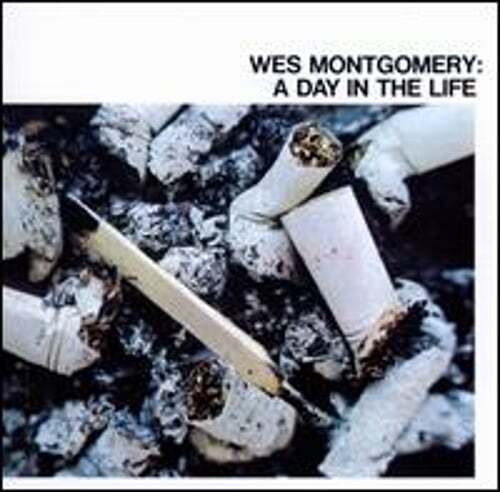By: Jason Young
 When Wes Montgomery, the most influential jazz guitarist of the 1960’s, introduced a new audience to his playing with the seminal jazz-pop album A Day In The Life, he received fanfare and criticism. Entering the golden age of AM radio with jazz versions of counter-culture favorites, the commercially savvy album presented jazz to a generation reared on transistor technology. With AM radio music directors now turning their attention to commercial jazz, Wes’s partnership with famed producer Creed Taylor proved good timing.
When Wes Montgomery, the most influential jazz guitarist of the 1960’s, introduced a new audience to his playing with the seminal jazz-pop album A Day In The Life, he received fanfare and criticism. Entering the golden age of AM radio with jazz versions of counter-culture favorites, the commercially savvy album presented jazz to a generation reared on transistor technology. With AM radio music directors now turning their attention to commercial jazz, Wes’s partnership with famed producer Creed Taylor proved good timing.
Featuring The Beatles’ hit songs “A Day In The Life” and “Eleanor Rigby,” along with other Top Forty hits, the bebop guitarist shared the airwaves with pop singers like Petula Clark, Bobbie Gentry and Lulu.
His transition from hard bop jazz to pop – although receiving its fair share of criticism over the years – is considered by many to have inspired smooth jazz artists like George Benson, whose popular hit “Breezin” reflects Wes’s influence. Record Review jazz editor Scott Yanow wrote; “In most cases, the guitarist [Montgomery] did little more than play the melody, using his distinctive octaves, and it was enough to make him saleable.”
Although penniless, Wes had become a star before he signed with the hit-making producer Taylor. A late start (Wes was in his 40’s), his album The Incredible Jazz Guitar of Wes Montgomery earned him much-needed recognition, and is hailed by jazz fans as his pinnacle.
“Setting him apart from the rest, this recording established Montgomery as the most formidable modern guitarist of the era, and eventually its most influential,” the music critic Michael G. Nastos wrote.
A tireless and financially strained Indianapolis club performer, Wes signed with Orrin Keepnews of Riverside Records at the prompting of famed saxophonist Cannonball Adderley. After four years with Keepnews – a time jazz critics consider to be Wes’s most creative – the Riverside label was experiencing financial trouble. With his label now bankrupt, Wes’s manager John Levy approached Taylor to sign the guitarist to Verve. A prolific jazz producer with scores of artists to his credit, Taylor’s partnership with Wes would merge jazz and pop genres, gaining airplay and chart success.
Intent on making commercial jazz records, the visionary Taylor recorded six Wes Montgomery albums released under the Verve label, including Movin Wes, Bumpin, and California Dreaming, before switching to A&M.
Despite criticism for catering to easy-listening audiences, the album features the guitarist’s biggest hit, a rendition of the #1 best-selling song of the summer of 1967, “Windy,” by the California rock band The Association. Wes’s version reached #44 on the Billboard Hot 100, making him a staple on Top 40 radio, and frequently performing the song on television appearances.
Riverside’s Keepnews reflected on the guitarist’s financial dilemma; “In the first year he’s working, a couple of records come out and attention is paid to him. All of a sudden, he’s the new star on his instrument…His reaction to that was to complain about the fact that he still wasn’t working very much or making much money. I said to him specifically, ‘Hey Wes, a year ago you were unknown and broke. Now you’re a star and broke. That’s tremendous progress.’”
On his time working with Wes, Keepnews reflected; “Literally, we were not working to sell records. We were working to present the artist in the best possible way and to get the most out of the artist as a performer, as a player. Probably, it would have been a nice idea if we had been a more aggressive sales unit. On the other hand, when Riverside disappeared and he went onto his Verve and A&M associations, quite clearly the goal was to turn him into the biggest seller possible. He was handled like a pop artist.”
Yanow described hard bop in the late 60’s as “running out of gas,” stating that major jazz labels like Blue Note were declining in sales, and that the fast rise of soul jazz and fusion replaced bop’s prevalence within jazz. Wes’s move from jazz to pop – still subject to debate – and his album A Day in The Life, continues to please listeners, and fires up jazz critics.
One year after the release of A Day in The Life, Wes would be gone, passing away unexpectedly of a heart attack at the age of 45.
About Jason Young: Born in Philadelphia, Pennsylvania, Jason is a forty-year music veteran. A guitar prodigy at the age of eight, he dedicated his life to writing music, audio engineering, and becoming fluent in drums, piano, mandolin, banjo, dobro, and bass. Also a singer and performer, he and his brother formed the band The Young Brothers. Writing a song with Kid Rock for the Rebel Soul album adds to his list of music accomplishments. Jason’s love of music spans rock ‘n’ roll, country, blues, and jazz. Passionate about music history, Jason is knowledgeable in many genres and enjoys writing about performers. Today, Jason focuses on writing articles for his Blue Railway Podcast website.
This article was originally published at Jerry Jazz Musician – used with permission.